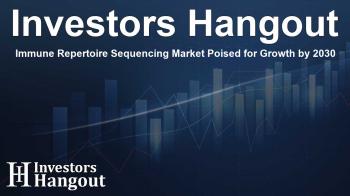Immune Repertoire Sequencing Market Poised for Growth by 2030

Overview of the Immune Repertoire Sequencing Market Growth
The global Immune Repertoire Sequencing (IRS) market is set for notable expansion, with forecasts indicating a growth from US$344.2 million in 2024 to approximately US$560.5 million by the year 2030. This growth, anticipated at a compound annual growth rate (CAGR) of 9.6%, is primarily driven by significant technological advancements in genomics and an increasing shift towards personalized medicine.
Factors Driving Market Expansion
One of the key factors propelling the IRS market is its pivotal role in research, especially in the realms of oncology and autoimmune diseases. These sequences provide critical insights that aid in therapeutic discoveries and treatment strategies tailored to individual patient needs. The growing trend towards immunotherapy, which utilizes the body's immune system to fight diseases, further amplifies the need for sophisticated sequencing technologies.
Moreover, the integration of artificial intelligence (AI) and machine learning (ML) into sequencing methodologies is paving the way for innovative applications in vaccine development and organ transplant monitoring. These advancements highlight the market's potential, as they enhance the precision and efficiency of immune profiling.
Market Segmentation Analysis
The IRS market can be segmented based on products, applications, and geographic regions. In terms of products, the market is primarily divided into two segments: assay kits & reagents and instruments & software. Notably, assay kits & reagents are expected to dominate the market. This is largely due to the heightened demand for reproducibility and standardization in immune profiling workflows, a critical need for researchers and clinicians aiming to enhance the quality of their studies.
When looking at applications, the IRS market has various segments including research, drug discovery & development, and clinical diagnostics. The research segment currently holds the largest market share, mainly due to the rising utilization of IRS to meet the urgent demands in cancer treatments and other immune-based therapies. This trend is likely to continue as developments in technology evolve.
Regional Insights
Geographically, the IRS market is spread across several regions, specifically North America, Europe, Asia Pacific, Latin America, the Middle East, and Africa. Notably, North America is forecasted to maintain the largest share of the IRS market, attributed to its advanced healthcare infrastructure and robust regulatory frameworks that support innovation. The Asia Pacific region is expected to exhibit the highest growth rate due to increasing investments in research and development, alongside government initiatives promoting biotechnology advancements.
Key Players in the Market
Several prominent companies are leading the way in the IRS market. Noteworthy players include Illumina, Inc., Thermo Fisher Scientific Inc., PacBio, and Oxford Nanopore Technologies, among others. Each of these companies boasts unique technologies and innovative platforms that cater to the diverse needs of the market.
Illumina, Inc., for instance, is well-known for its NovaSeq X and AmpliSeq TCR kits, offering comprehensive TCR and BCR profiling. Meanwhile, Thermo Fisher Scientific is recognized for its Ion Torrent platforms and Oncomine assays, which provide end-to-end sequencing solutions.
Other notable contributors to the IRS sector include 10X Genomics, offering high-resolution analysis of TCR/BCR diversity, and PacBio, which provides precise full-length analysis capabilities with its HiFi sequencing systems.
Conclusion and Future Outlook
The immune repertoire sequencing market is on the brink of a significant evolution, driven by ongoing technological innovations and changing healthcare paradigms. With the potential to transform treatment methodologies and enhance patient outcomes through personalized medicine, the IRS market represents not only a lucrative investment opportunity but also a crucial avenue for future biomedical research.
Frequently Asked Questions
What is the projected growth rate of the IRS market?
The IRS market is expected to grow at a CAGR of 9.6% from 2024 to 2030.
Which segment is expected to dominate the IRS market?
Assay kits and reagents are expected to dominate the IRS market due to the rising demand for reproducibility in immune profiling.
What applications are driving the demand for IRS?
Research, drug discovery, and clinical diagnostics are the main applications driving the demand for immune repertoire sequencing.
Which regions are seeing the highest growth in the IRS market?
The Asia Pacific region is projected to experience the highest growth rate in the IRS market due to increased research and development initiatives.
Who are the key players in the IRS market?
Key players include Illumina, Inc., Thermo Fisher Scientific Inc., PacBio, and Oxford Nanopore Technologies.
About The Author
Contact Dominic Sanders privately here. Or send an email with ATTN: Dominic Sanders as the subject to contact@investorshangout.com.
About Investors Hangout
Investors Hangout is a leading online stock forum for financial discussion and learning, offering a wide range of free tools and resources. It draws in traders of all levels, who exchange market knowledge, investigate trading tactics, and keep an eye on industry developments in real time. Featuring financial articles, stock message boards, quotes, charts, company profiles, and live news updates. Through cooperative learning and a wealth of informational resources, it helps users from novices creating their first portfolios to experts honing their techniques. Join Investors Hangout today: https://investorshangout.com/
The content of this article is based on factual, publicly available information and does not represent legal, financial, or investment advice. Investors Hangout does not offer financial advice, and the author is not a licensed financial advisor. Consult a qualified advisor before making any financial or investment decisions based on this article. This article should not be considered advice to purchase, sell, or hold any securities or other investments. If any of the material provided here is inaccurate, please contact us for corrections.

